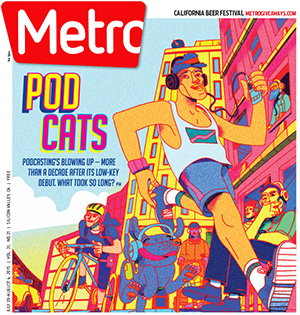Features & Columns
The Podcast Invasion
 In a world overflowing with screens, audio-only is exploding.
In a world overflowing with screens, audio-only is exploding.
In the gray, quick-fading winter light, they gather. In living rooms, in kitchens or on front porches, attentive and transfixed, they listen as voices spill out of the speakers. Huddled in a circle, they collectively gasp, grin, grimace and shake their heads in disbelief at the lurid details of a convoluted true-crime story packed with police procedural work and courtroom bravado, about a pair of estranged lovers and the murder that will forever link them.
From the sound of footsteps crunching through dead leaves, each listener creates a mental image of the park where the rope was found. Interstitial musical motifs signal a change of scenery or simply provide a break in the action—a chance to collect one's thoughts.
The scene might call to mind a 1940s American family gathered around a large, wood-paneled tube radio for the evening broadcast of The Lone Ranger, The Green Hornet or Buck Rogers.
But this is December 2014. If there is a terrestrial radio in the room, it is not carrying this broadcast. The program, NPR's wildly popular Serial, is being piped through the speakers from a laptop, smartphone or other mobile device.
The Serial listening parties are more than an indication of the program's popularity. Yes, the show, hosted by Sarah Koening, is a smash hit—it clocked 41 million downloads by the end of last year and holds the record, among podcasts, as the fastest to fly past the 5 million download mark.
But these gatherings also point to a broader trend. More than a decade after its low-key launch, podcasting is enjoying a massive surge in popularity. From programs first established on the radio, like This American Life and Radiolab, to others, first established on TV, like Mad Money w/Jim Cramer and The Daily Show Podcast without Jon Stewart, to shows like WTF, which catapulted comedian Marc Maron into the spotlight after years of toiling as a lesser-known standup act—more people than ever are making podcasts, and more people are tuning in.
Some of the freshest faces on the podcasting scene are Rosie La Puma and Eileen Williams, undergraduate students working with the Stanford Storytelling Project. The project aims to "promote the transformative nature of traditional and modern oral storytelling" by giving students the skills and tools to create their own audio stories.
Both rising juniors at Stanford, La Puma and Williams are longtime fans of podcasts, as well as NPR and audio storytelling in general—even though they've grown up in a world saturated with screens and 1,000-channel cable packages.
La Puma wasn't yet a teenager when WiFi became ubiquitous and people began carrying tiny, touch-screen computers in their pockets. Still, she says that podcasts—essentially terrestrial radio on-demand—are quite popular among her peers. And why shouldn't they be?
"The classic (line) is 'video killed the radio star,' but I think radio is discovering what purposes it can fill that video can't," La Puma says. "Because you can listen to radio while doing other tasks."
In a world where a WiFi connection can be found at every coffee shop and everyone has a smart phone and a laptop near nearby, work follows us wherever we go. It's harder to find time to consume long-form, narrative-style journalism these days. That's where podcasts come in.
"I just don't have that time anymore," she says. "But I can get that via radio (and podcasts)." Williams says she will listen to podcasts while tidying up, folding laundry, driving, exercising and in labs. She says she even listens at night as she is falling asleep, sometimes. "I can get a lot more depth from radio than I can from reading a (short blurb) on the Internet."... continue reading


